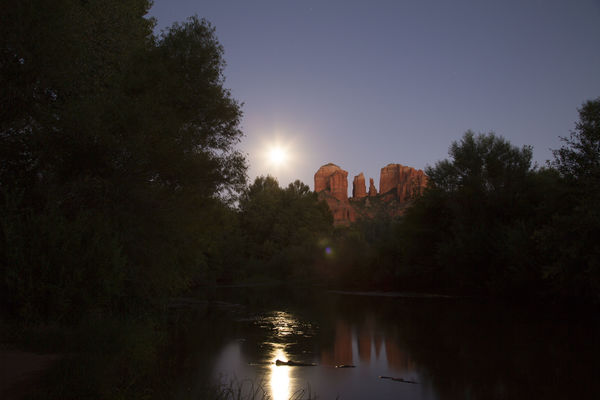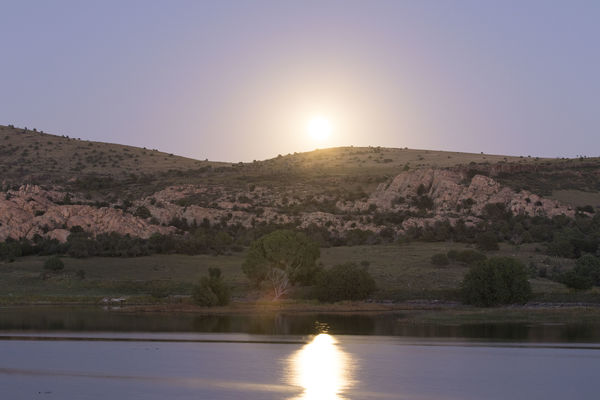Trouble photographing the full moon
Sep 19, 2016 15:38:01 #
Attached are two photos I took recently trying to incorporate the full moon in the shot. As you can see from the photo, the full moon did not come out properly. Any suggestions what went wrong and how to correct the problem so it doesn't happen again.
Sep 19, 2016 15:43:26 #
Sep 19, 2016 16:02:44 #
It's an exposure issue. You will need to use manual exposure settings.
At f8 and 30 sec at ISO100 your camera overexposed the moon by about 14 stops, if I counted correctly.
People frequently don't think about the fact that the moon is in direct sunlight so the old rule of thumb for direct sunlight exposure,
the 'sunny 16 rule' tells us that the exposure would be 1/ISO @ f16. In your case 1/100 at f16.
You might need to play around with exposure compensation a bit but 1/100 @ f16 will be a good starting point.
At f8 and 30 sec at ISO100 your camera overexposed the moon by about 14 stops, if I counted correctly.
People frequently don't think about the fact that the moon is in direct sunlight so the old rule of thumb for direct sunlight exposure,
the 'sunny 16 rule' tells us that the exposure would be 1/ISO @ f16. In your case 1/100 at f16.
You might need to play around with exposure compensation a bit but 1/100 @ f16 will be a good starting point.
Sep 19, 2016 16:13:18 #
Ideas for shooting the moon when moonrise/moonset are close to sunset/sunrise:
http://www.uglyhedgehog.com/t-412050-1.html
More:
http://www.uglyhedgehog.com/t-281430-1.html
-
http://www.uglyhedgehog.com/t-412050-1.html
More:
http://www.uglyhedgehog.com/t-281430-1.html
-
Sep 19, 2016 16:25:23 #
Is the time on your camera set incorrectly - or were these not shot in Prescott? First says 7 a.m. Moon was long gone by then.
Oh, #2 looks correct though: sunset 6:34, moonrise, 6:47. #2 had the potential to include a bit of landscape detail (was there still a bit of light or did the hill obscure the moonrise 'til quite dark out?) if you had exposed for the moon, as mentioned above. Even once you understand about the brightness, hedge your bets with a few exposures to either side of what seems perfect.
I use this site as I have no smart phone - lol:
http://aa.usno.navy.mil/rstt/onedaytable?ID=AA&year=2016&month=9&day=15&state=AZ&place=prescott
However, as with your shots, obstructions of hills and other will affect the actual time you see, or the time you lose it at moonset.
Oh, #2 looks correct though: sunset 6:34, moonrise, 6:47. #2 had the potential to include a bit of landscape detail (was there still a bit of light or did the hill obscure the moonrise 'til quite dark out?) if you had exposed for the moon, as mentioned above. Even once you understand about the brightness, hedge your bets with a few exposures to either side of what seems perfect.
I use this site as I have no smart phone - lol:
http://aa.usno.navy.mil/rstt/onedaytable?ID=AA&year=2016&month=9&day=15&state=AZ&place=prescott
However, as with your shots, obstructions of hills and other will affect the actual time you see, or the time you lose it at moonset.
Sep 19, 2016 16:46:37 #
Shellback wrote:
Technique for photographing the moon: https://photographylife.com/how-to-photograph-moon
Thank you, I'll try those settings for the next Full Moon.
Sep 19, 2016 17:09:14 #
Linda From Maine wrote:
Ideas for shooting the moon when moonrise/moonset are close to sunset/sunrise:
http://www.uglyhedgehog.com/t-412050-1.html
More:
http://www.uglyhedgehog.com/t-281430-1.html
-
http://www.uglyhedgehog.com/t-412050-1.html
More:
http://www.uglyhedgehog.com/t-281430-1.html
-
The first picture was shot in Sedona, AZ. by Oak Creek with Cathedral Rock in the distance. I needed to wait until the moon cleared the trees and started moving toward Cathderal Rock. Although the full moon started rising around 6:00 PM, it took a whole hour for it to clear the trees to be visible next to Cathedral Rock. This picture was shot at 7:07 PM. Everything went according to plan with the exception of a nice round full moon by the rock. It was very disappointing to wait all that time and not get what I came for.
The second picture was shot at Watson Lake in Prescott, AZ and the same situation ensued, that is, I had to wait for the Full Moon to clear the hill which took some time from the scheduled full moon rising time.
Sep 19, 2016 21:54:38 #
If you want to have the moon over a landscape you need to do two exposures and blend them. One shot for the landscape/horizon and one for the moon then during PP you put the properly exposed moon and the properly exposed landscape together as one image.
Sep 19, 2016 22:46:46 #
How about bracketing three exposures and combining them like an HDR shot. Do you think that would work?
Sep 19, 2016 22:56:04 #
stumbo wrote:
How about bracketing three exposures and combining them like an HDR shot. Do you think that would work?
Yes, an HDR would allow you to get a good exposure on the moon and the foreground.
Experiment with the different exposures required between the moon and foreground.
You might not be able to use the bracketing range built into your camera if the exposures required are too far appart but you can always do it manually.
Rick
Sep 19, 2016 23:09:24 #
Thank you Rick. In fact, I have some past moon shots where I bracketed and they came out fine. I tried bracketing in both the Sedona and Prescott shots I recently took and it didn't work. I guess I'm going to have to experiment with various settings and bracketing to see what works all the time.
Sep 19, 2016 23:13:55 #
stumbo wrote:
Thank you Rick. In fact, I have some past moon shots where I bracketed and they came out fine. I tried bracketing in both the Sedona and Prescott shots I recently took and it didn't work. I guess I'm going to have to experiment with various settings and bracketing to see what works all the time.
You are welcome.
Often, experimentation is the only way to find the exposures when dealing with extremes like your shots.
Sep 20, 2016 07:37:05 #
robertjerl wrote:
If you want to have the moon over a landscape you need to do two exposures and blend them. One shot for the landscape/horizon and one for the moon then during PP you put the properly exposed moon and the properly exposed landscape together as one image.
👍
Sep 20, 2016 07:51:22 #
Quote: "It was very disappointing to wait all that time and not get what I came for."
Practice, practice. I know the feeling. My first attempts at BIF (birds in flight) really showed me that as well. Robertjerl gave us the way to go with his comment. Moon exposures can fool your meter into averaging, unless you've got a good sized telephoto lens and a tight reading spotmeter. For your shot, including foreground in a moon shot is tough because the foreground will need more exposure, and the moon less.
Practice, practice. I know the feeling. My first attempts at BIF (birds in flight) really showed me that as well. Robertjerl gave us the way to go with his comment. Moon exposures can fool your meter into averaging, unless you've got a good sized telephoto lens and a tight reading spotmeter. For your shot, including foreground in a moon shot is tough because the foreground will need more exposure, and the moon less.
Sep 20, 2016 08:50:50 #
dlmorris
Loc: Loma Linda, Ca
What you will need to do is shoot one day earlier, so there will be more light on the foreground, so you don't need as long of an exposure, blowing out the moon. The moon won't be "full" but no one will notice. Otherwise, you'll have to use multiple exposures and do some major post processing. By the way, I like your first shot, even as it is.
If you want to reply, then register here. Registration is free and your account is created instantly, so you can post right away.






